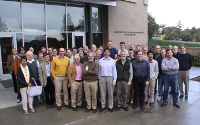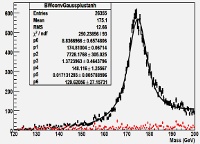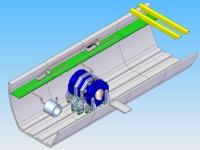 |
 |
|||||||||||||
|
|||||||||||||
|
|||||||||||||
|
A Silicon Detector (SiD) workshop was held at SLAC from 2 to 4 March, with the express purpose of reviewing the status of the SiD Letter of Intent, organising the final steps in its completion, and beginning to think of life after the LOI. Persis Drell, the SLAC Director, opened the meeting by welcoming the collaboration to SLAC, and restated her firm conviction that the science case for the linear collider was as strong as ever. She noted shortcomings in the present US strategy to realise the ILC, and committed to working with others towards a remedy. Barry Barish followed Persis with a review of the Global Design Effort's considerable technical progress and a renewed commitment to be ready with a strong proposal to funding agencies in 2012. The body of the meeting was devoted to detailed reviews of SiD's LOI contributions, subsystem by subsystem, with a special emphasis on new physics benchmarking analyses. Mountains of data have been generated, reconstructed, moved, and analysed, and physics analyses are racing to be ready for prime time. The SiD LOI editors, Hiro Aihara, Phil Burrows and Mark Oreglia, introduced and monitored progress throughout the meeting and issued to-do lists at the end. Sakue Yamada made a phone appearance, outlining the next steps in the International Detector Advisory Group's evaluation process and his plans to guide the detector concepts towards full proposals on the GDE timetable (see also this week's Research Director Report).
In addition to dealing with the LOI proper, the collaboration also looked to SiD's future. Ivan Alvarez from Santander invited SiD scientists to participate in the Spanish detector R&D meetings. Michael Peskin stirred up discussion with his advocacy of a staged linear collider, beginning with a photon-photon collider capable of studying the Higgs. Konrad Elsener (CERN) described the many areas where SiD and Compact Linear Collider Study (CLIC) detector interests overlap and invited collaboration. At the end of the meeting, Harry Weerts reviewed the critical issues SiD had confronted during the meeting, and noted that "there has been a positive shift in the US funding agencies' willingness to support linear collider detector R&D." John Jaros concluded the presentations with thanks to SiD's "undercarriage", remarking that the SiD Collaboration has withstood significant pushes and pulls and periods of minimal luminosity, but it has a string of amazing accomplishments, soon to include the SiD LOI. -- Tom Markiewicz, SLAC |
|||||||||||||
| © International Linear Collider |


